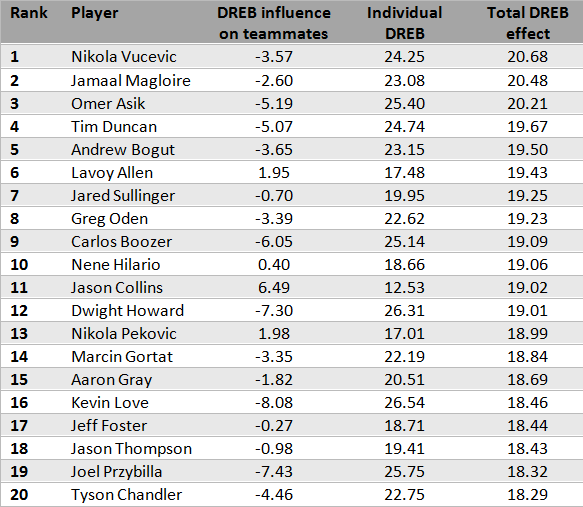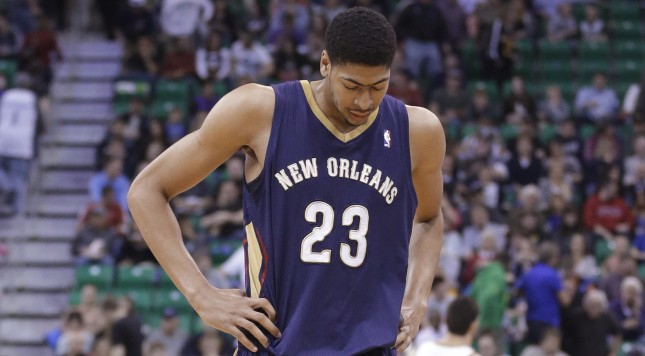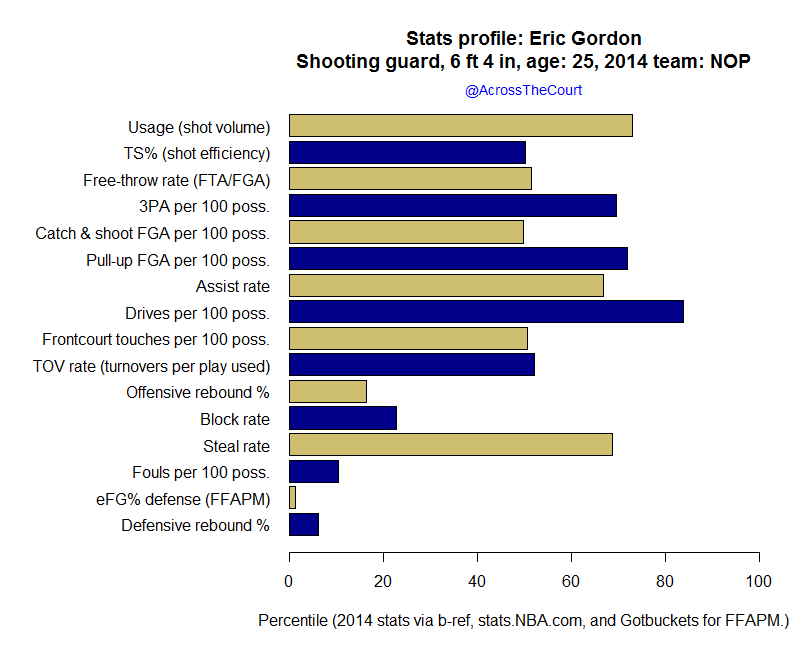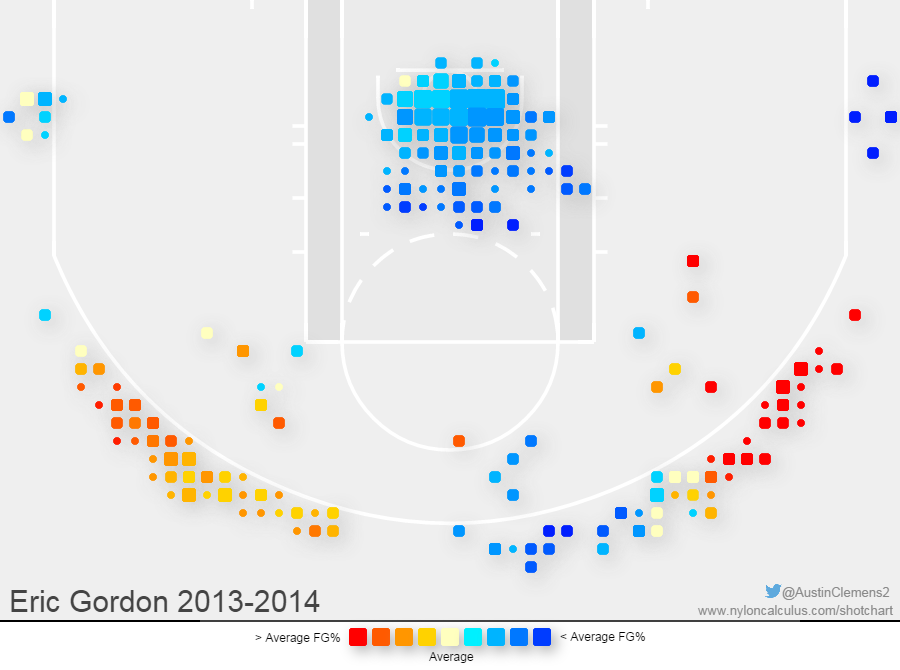The future of the New Orleans Pelicans centers on Anthony Davis and how they can support him with talent. They’ve tried a reset with the franchise, giving the team a new name, and Chris Paul is now but a distant memory in New Orleans. But in a competitive west, the playoffs are as hard to reach as ever.
2014 in review
There are two different storylines for the Pelicans in 2014. One is about Anthony’s amazing season and how his 20/10 season with 2.8 blocks has only been accomplished by legendary big men. He’s a shotblocking terror who can reach shots few others can and come in from nowhere to swat away attempts, but he also has developed a very good offensive game, using his length and athleticism as a formidable weapon in pick-and-roll’s and other attacks at the basket with a much improved jumper. The other story is of a miserable team with an atrocious defense, barely better than three other squads. Even the 76ers were better. Jrue Holiday, normally an iron-man, played only 1100 minutes, and his duties were shared by lesser players Brian Roberts and Austin Rivers. Ryan Anderson was also knocked out of the season and dealt with personal tragedy. Then Davis continued to have issues playing center full-time and had to be paired with limited big men like Ajinca and Stiemsma. They won 34 games — but at least Anthony Davis was an all-star.
Changes
Exit: Al-Farouq Aminu, Brian Roberts, Anthony Morrow, Greg Stiemsma, Jason Smith, Lou Amundson, Lance Thomas, James Southerland, Melvin Ely, Arinze Onuaku, Josh Childress.
Enter: Omer Asik, John Salmons, Jimmer Fredette, Dionte Christmas, D.J. Stephens
.
The Pelicans traded their first round pick for 2015 for Omer Asik in the last year of his contract. They’re confident they can re-sign him, and a mid-teen’s draft pick is usually a pretty mediocre player and easily replaceable. Teams lately have been overvaluing draft picks, and New Orleans could absorb Asik this season while Davis is still on his rookie contract. Aminu’s defense and rebounding will be missed, but his shot is still inconsistent. He’ll be replaced by Salmons, who’s a risky bet given his age and age-induced dwindling production. The role of back-up point guard, once held by Brian Roberts and his league-leading free-throw percentage, will ostensibly be taken by Austin Rivers. Jimmer’s role on the roster is to replace the dead-eye shooter role Morrow had. Stiemsma and Smith were part of the collective big men cast used to simulate a real frontcourt partner for Davis — they won’t be needed with Asik and a healthier Anderson.
Player spotlight
As the central piece in the franchise-altering Chris Paul trade, Gordon’s had a disappointing career marred by injuries. He had potential as a slashing guard with an outside shot and point guard skills on a strong frame. Even now, via the bar chart below, he’s still a good offensive player with a varied skillset led by a high number of drives. He’s either average or a little above average in every offensive category with the exception of rebounds. But he’s just not a significantly powerful offensive force given a pleasant but not great usage rate and average efficiency.
Defensively, there’s little evidence he even runs over to the other side of the court besides his steals. Gordon once had solid defensive potential, but after his injuries he’s lose to being a liability. Metrics like ESPN’s RPM see hims as a terrible defender, and it’s a terrible sign for a starter when his team, already a poor one on defense, is league average without him on the court and beyond league worst with him.
From Gordon’s shot chart below, his tendencies and skills are clear. He’s a good shooter on both wings and drives frequently to the basket. Unfortunately, he’s a below average finisher, and outside of his 2011 campaign that’s the norm. He’s especially poor at the in-between shots from 3 to 8 feet — he needs a better floater like Tony Parker. He doesn’t take a lot of midrange shots, and when he does they’re near the elbow. Similar patterns hold for other seasons as well.
In a game versus Memphis, you can see Gordon’s full range of moves (link’s also here) against a superior defense. The first and third videos show fast break points, where the third one includes a tough shot over the outstretched games of Mar Gasol. The second video has Gordon spotting up for three on one of his favorite spots, the wing. He shows a nice off-the-ball move in the fourth by cutting to the rim for a lay-up. In the fifth he creates his own shot at the rim with a long drive. And finally, he utilizes a floater over Marc a few feet from the basket.
You can see some of Gordon’s poor defense in the first video below in the playlist below. He strays too far in the paint while guarding Klay Thompson, who can’t be left alone at the three-point line. Klay catches it, and Eric doesn’t get back in time to contest the shot. Klay misses, but the Warriors get the offensive rebound, Eric loses track of him, and Thompson hits a follow-up three. He does, however, have quick hands, which you can see in the second embedded video below when he strips Tony Parker.
Eric Gordon hasn’t fulfilled his potential he had at the time of the Chris Paul trade, but he’s still a useful offensive player, scoring a few different ways with some playmaking skills. His defense is a mess though, and it’s difficult to tell how much of this is a team-wide coaching issue and how much it’s Gordon’s limitations due to awareness, size, and reduced athleticism. For Anthony Davis to reach the post-season, his teammate will need to clear up some of his issues and stay healthy.
2015 projected
The trickiest teams to predict are those that rely on young players and those that are controlled by injuries. New Orleans is both. I don’t know if I should expect the Asik from 2013, a guy who would have deserved Defensive Player of the Year, and how much his disappointing season in Houston matters. He missed his first regular season game last season, and then he missed 33 more. His defense was worse too. Eric Gordon’s messy to predict as well — in his first season in New Orleans he played 200 minutes and he’s been missing chunks of games since his sophomore season. Jrue’s coming a injury-plagued season, and one can’t pencil him in for another 2900 minute season — but how much will he play? Given the team’s poor depth, these are pertinent questions.
Anthony Davis had all the incidental stats of a superstar, but it hasn’t translated well to the court yet. New Orleans defended about the same whether or not he was on the court, and it’s not like he was being backed up by some defensive wizards either. He can block 3 shots a game, but what’s that matter with respect to the actual scoreboard? New Orleans opponents still shot at a top 4 percentage and volume within 3 feet of the rim. Their worst problems on defense were shots inside and giving up too many free throws, tasks controlled by your big men.
For the first couple years of his career, Kevin Durant had some of the worst plus/minus numbers in the league, contrary to gaudy shooting stats and an improved shooting percentage in his second season. Yet he completely turned those around in this third season and ranked second overall by one measure. In some respects this is bizarre; we expect data to be smooth and predictable. But young players, especially superstars, improve quickly and in discontinuous leaps. The nuances of defending the league’s bread and butter, the pick and roll, will suddenly click, and perhaps a team will change their defensive philosophy to suit a player’s strengths.
Anthony Davis is poised to take that leap and turn that storm of arms and limbs into a defensive plus/minus force. Asik could help tremendously here, taking most of the physical assignments and letting Davis roam. One unintended consequence is that Davis may not be able to average 10 plus rebounds again with Asik grabbing everything. Davis averaged almost exactly 10 rebounds a game, and Asik has been grabbing 30% of every available defensive rebound in recent seasons. That kind of defensive rebound percentage happens only like twice a year. In fact, based on a 7-year rebounding study, he has the third greatest effect on defensive rebounds ahead of Tim Duncan and just behind Vucevic and Magloire.

*Per 100 rebound opportunities
**2008-14
The third column shows the influence the player has on the other four teammates on the court with defensive rebounds. Most high-level rebounders “steal” rebounds away from their teammates because they’re grabbing a large portion of the available rebounds, and Asik is no exception: he takes 5.2 away, per 100 opportunities.
What mistakes Davis and Asik rectify inside, the problem will remain on the perimeter. Jrue Holiday is probably their best defender out there now, while Salmons and possibly someone like Rivers will be used as stoppers. Renewed commitment to defense could help Gordon and Evans, but the team has a long way to go. Optimistically, Asik could reenact his remarkable job in 2013 holding together a defense that featured Harden and a mix of young players and keeping them a little above average.
The offense, however, could have moments of beauty with three slashing players using screens from Asik and Davis or relying on the long-range bombing of Ryan Anderson. Davis is known for his defense now, but 20 points on great efficiency is outstanding for a big man. Asik isn’t a scorer, but he’s one of the best at setting picks and he can crash the offensive glass when the other four scorers miss. This is the optimistic perspective, however, ignoring the thin bench and Jrue Holiday’s shot selection, but it should be enough for a winning record.
Summary
Anthony Davis has put up some incredible numbers for someone of his age, but there’s only one that matters now: how they outscore their opponents. Asik lets Davis slide to a more comfortable power forward position where he can’t be pushed around, and they should be able to lock down the paint and control the rebounds. Also important is Ryan Anderson back from injury, giving the Pelicans a top-tier offensive weapon in the frontcourt and addressing their weakness last season. The trio of Holiday, Evans, and Gordon have been disappointments since coming to New Orleans, but they can focus on their strengths and what roles they provide on the team. Defense will be a problem in the backcourt, however, and the team will get burned from lacking a defender there. That could mean the difference between the lottery and the playoffs.
Wins: 41
Losses: 41
Conference rank: 11th
League offense rank: 9th
League defense rank: 23rd
Edited 10/27/2014






















